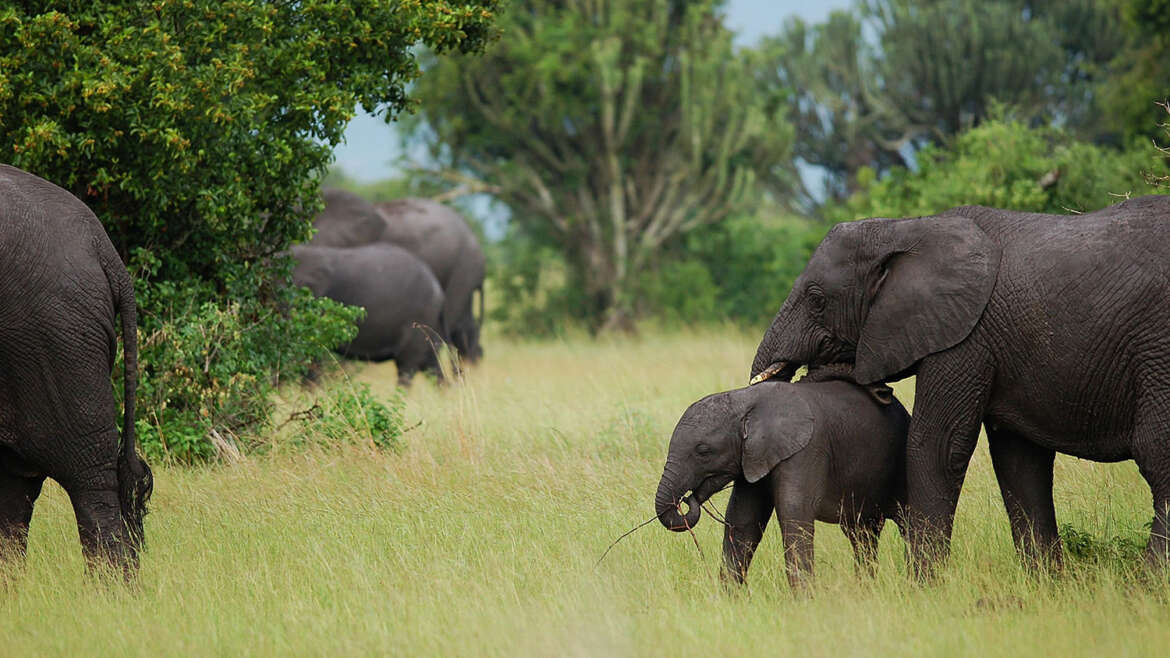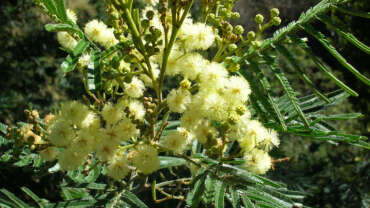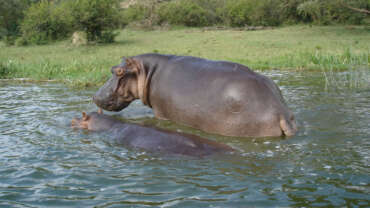Wildlife Tourism in Uganda
Elephants
Elephants have miles of unbroken savanna to roam inside Uganda’s Queen Elizabeth Park, where their numbers total 2,500, a dramatic rise after heavy poaching in the 1980s. Outside the preserve villagers kill elephants that trample and eat crops, though attacks have diminished with the digging of trenches to protect fields from wild trespassers. Elephants have longer pregnancies than almost any other mammal. They carry their calves for 22 months, and cows usually only bear one calf every two to four years. Reproduction rates are not sufficient to sustain population numbers at the current poaching rates.
Spotted Hyena
The spotted hyena’s famous “laugh” is actually a sound made to alert other group members to a source of food. This noise can be heard up to three miles away, and is one of many sounds made by this sociable species to communicate with each other. Hyenas are skilled hunters as well as scavengers, and their large, powerful jaws allow them to chomp through every part of their prey, including the skin and bones. The only parts which cannot be digested are hair, horns and hooves the hyena will regurgitate these in pellets.
Hyenas are found in many habitats, including woodland, savannah and desert, though being nocturnal, they are rarely observed. Human-wildlife conflict has long been a problem. Hyenas are known to have eaten people, though it is more likely that they will kill livestock, which results in them being targeted by hunters.
Golden Monkeys
Uganda is one of African countries that offer an opportunity to see golden monkeys and the best place to track golden monkeys on a Uganda tour is Mgahinga Gorilla National Park. Mgahinga national park is one of the 5 mountain gorilla parks in the world. Due to the park’s setting amidst the thick bamboos forest of Mgahinga National Park well as the forest being in the shadows of the 3 Virunga volcanoes in Uganda. This kind of atmosphere provides a simply amazing backdrop to the tracking of the Golden Monkeys and therefore the best setting for Golden Monkey tracking and this activity is done at the lowest price.
In the Mgahinga Gorilla Forest, Tracking Golden Monkeys like Gorilla Tracking and Chimpanzee Tracking in Uganda starts at 8 am with an orientation and then setting off in a small group with guides up into the Bamboo Forests in search of the Golden Monkeys and of course the other mammals you will see along with birds and the scenic setting of the park.
Golden Monkey are simply attractive looking monkeys with color, their playful ways, and since they have been habituated – they are used to seeing humans and do not scamper off as you approach a bit of advice is in taking pictures of the monkeys, they move rather quickly and you will need to set your camera on fast shutter speed and due to the bamboo forest on low light setting.
Leopard
The striking leopard is one of the hardest large species to observe in Uganda, thanks to its nocturnal, solitary behavior and well-camouflaged coat. Their survival is partly due to their adaptability to warm and cold climates and ability to climb trees while carrying heavy prey – keeping it safe from other predators such as lions and hyenas. They can run at incredible speeds of up to 58 km (36 miles) per hour, and hunt antelopes and monkeys as well as fish, birds, insects and reptiles. Historically, leopards were hunted for their beautiful fur; loss of habitat is now their greatest threat. Mainly spotted at Kidepo valley national Park, Queen Elizabeth national Park, semiliki National Park, Lake Mburo National Park, Murchsion Falls National Park.
Lions
Lions are among a few big cats found in Uganda’s National Parks and it is among the most wanted to be seen animal while on game drive. Research indicates that 90% of most clients from all Tour Companies will ask their drivers to look for lions. And there will always be big excitement on spotting the King of the jungle, after the lion, the demand goes on to the Leopard.
A fully grown lion will normally weigh between 150-250kg for males whereas females can weigh between 120-182kgs, and can live in the wild up 14years. And in zoos, they can live for even 20years. Females will normally do most of the hunting.
Male lions will need atleast 7kgs of meat per day and 5kgs of meat per day for the females. After a big hunt example a Buffalo, a lion can consume up to 30kgs of meat and can sleep by for a simple digestion to consume more of the meat if other lions fail to finish the hunt. In open areas like Murchison falls National Park overlooking the Albert Nile, where there are many thickets, lions will normally pull Uganda Kobs, into the thickets so that they don’t get any disturbance from hyenas and moving Safari cars around.
Lionesses normally produce by the age of 4 years, and can mate with any male before it conceives and the mating can take up to several days. The gestation period is 110days after which a female will give birth from 1- 4 cubs normally in a secluded area like thicket which cannot be easily reached especially like the Hyenas who will normally want to kill and eat the cubs. The cubs will normally weigh 1.2–2.1 kg.With a close look at a cub (baby lion) there are brown spots on their bodies, but they will always fade as they reach adulthood
See tree Climbing Lions in Uganda at Ishasha. The lion being found up in the tree branch is a unique adventure moment as lions are often found in the open savannah grasslands roaming around, sleeping, resting or hunting. These lions will normally climb and rest in these fig trees when noon approaches. It is hard sometimes to find them up in the trees when it is raining, or when it is still slippery in the morning. These tree climbing lions of Uganda are found in Queen Elizabeth National Park in the Southern section near the Congo boarder.
The best places to find the lions are kidepo Valley National Park, Murchison Falls national park, Queen Elizabeth National Park.







